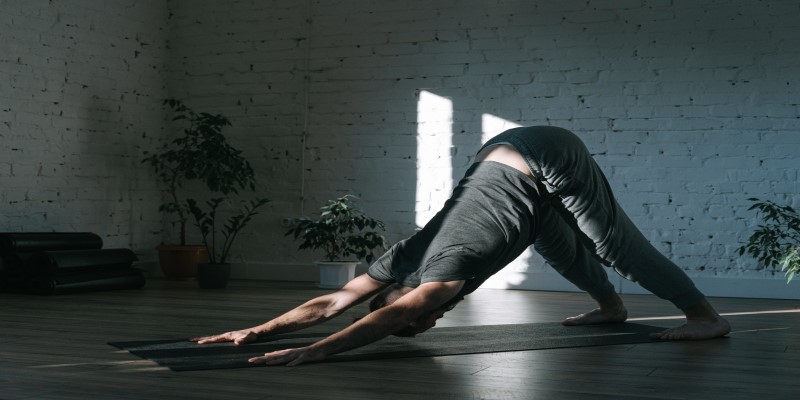Almost everyone who has taken a yoga session has performed downward dog. This is a well-known pose that you have probably done during a vigorous warm-up or following a workout cool-down, even if you are not a yoga practitioner. That is because this traditional yoga pose has several advantages.
Even though this pose looks simple, it requires entire-body coordination, which may be challenging to master. That could clarify why you're having trouble perfecting the form. These are some typical problems you could encounter when practising a downward dog, along with suggestions on how to make it safer, more efficient, and more body-friendly.
What is Your Body Trying to Tell You?
If you are struggling in performing the downward dog pose, here are the possible signals that your body might be giving you.
Your Calves Are Tight:
In a downward dog, tight calves can restrict ankle flexion and tug on your Achilles tendon, which can make it challenging for the heel to touch the ground. Additionally, you could make up for tight calves by bringing both hands nearer to the feet to assist your heels in contacting the ground. However, the compression and flexion of the spine at the front of one's body caused by this short posture might result in a rounded spine and perhaps strain on the back.
However, you can fix it. Use blocks underneath your hands or bend your knees into a down dog posture if your calves are stiff. This will help you distribute your weight evenly. You may also use foam rolling as well as calf stretches to relieve the tension in the calf muscles.
Your Shoulder Mobility Is Limited:

You most likely have stiff shoulders if you spend your days bent using a laptop. Furthermore, the downward dog tends to be hampered by this shoulder tightness. In a downward dog, shoulder problems will result in discomfort and pain.
Furthermore, stiff chest muscles are probably the cause of your limited mobility if a particular injury doesn't bring it on. This is a result of your habit of rounding your back and hunching your shoulders while you sit for extended periods of time. Your back and chest, or the front part of your body, relax or weaken when this occurs.
Avoid pushing yourself into a downward dog posture if there are problems with shoulder mobility. Alter the move instead. Yoga blocks are recommended by specialists, who advise placing each hand on a yoga block. You may also try resting both hands on a chair or a wall. With your lower back aligned to the floor and both of your hands pressed into the surface of the wall, take a leg-length distance far from the wall's surface and plant them there.
You Have Tight Hamstrings
Similar to tight calves, hamstrings can lead to the majority of your weight being transferred to the upper part of your body. Stiff hamstrings also negatively impact your form in numerous ways. In particular, they pull on the lumbar bones, curving their backs.
Experts advise doing stretches and postures like Padahastasana, Uttanasana, and Janusirsasana to extend the hamstrings. As an alternative, consider bending the knees into a downward dog. This will enable the spine to extend by letting the pelvis lean more.
Your Upper Body Muscles Are Weak
A downward dog feels like anything other than a resting posture when the upper body is weak. You'll most likely make up for it by hunching your shoulders close to your ears. However, this can set off a chain reaction of additional issues. Unusual pressure and discomfort in the wrists may result from shoulder instability or weakness.
Exercises like push-ups and pull-ups are among the quickest methods to build upper body strength. Additionally, you can practice downward dog form: Exercises like push-ups and pull-ups are among the quickest methods to build upper body strength. Additionally, you can practice downward dog form: Extend your arms beyond your ears, make sure both of your elbows are pointing in the opposite directions on the yoga mat, and widen your chest and collarbones.
Your Wrists Are Inflexible
If one has weak wrists, it may be challenging to evenly distribute the upper body weight in the downward dog position. Even worse, doing downward dog will hurt if you have weak or rigid wrists.
Experts recommend yoga blocks as a way to balance weight and relieve wrist strain. In the same manner, you may wrap up an additional yoga mat, towel, or blanket or place a foam wedge beneath your hands. This can make the position simpler by reducing the degree of extension on the wrist.
There's Not Much Ankle Mobility

In the downward dog position, restricted ankle mobility renders it more complex for your heels to descend towards the floor, which can cause problems up through the lower body to the spinal. Additionally, weak, tight ankles may unevenly transfer weight to the upper part of the body, just like tight hamstrings and calves do.
Hero position is one of the greatest yoga poses for improving ankle flexibility. As you gradually move down, begin with a few blocks beneath your seat as necessary. A downward dog may also be adjusted to be more comfortable.
Your Muscles Aren't Being Used Actively
Even though a downward dog is meant to be a relaxing and resting posture, you shouldn't stay in it all the time. According to experts, there is less equilibrium in how you distribute your body's weight when your muscles are not contracted. Your form gets worse as a result, which may cause discomfort.
Maintain a present-minded posture. Rotate your shoulders, spread your fingers, bring your heels down to the floor, and consciously focus on achieving complete body balance in this position.
The Bottom Line!
In conclusion, mastering downward dog yoga revolves around paying attention to what your body is saying and becoming better over time. Regardless of how tense your muscles are or how stiff your shoulders are, each challenge is an opportunity to improve. You may enhance your practice by observing the way you feel and by making little modifications. Remember that yoga is about achieving balance and feeling wonderful. Thus, don't give up; be patient, and enjoy the learning and development process.







